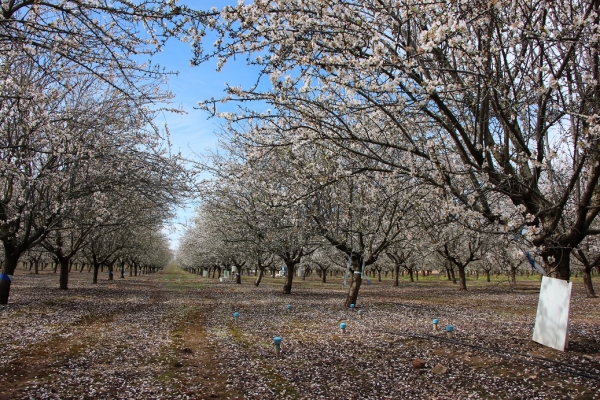In Spain, the drought between 1991 and 1995 led to restrictions in the allocation of water for crops and cuts in supplies. What would have happened at that time to the intensive, irrigated almond plantations that have been planted in Spain for more than a decade?
These plantations, planted on productive soilsfeaturing high tree density, continuous irrigation, and the use of fertilizers, occupy 140,000 hectares in the country ― 326% more than in 2015 according to the Ministry of Agriculture, Fisheries and Food. Therefore, knowing what would happen to them if a drought situation such as that of the 1990s arose is crucial to enable both regulatory agencies and the agricultural community to make evidence-based decisions.
In this context, a team made up of Elías Fereres and Álvaro López, researchers from the María de Maeztu Unit of Excellence in the Department of Agronomy at the University of Córdoba, together with researchers David Moldero, Luca Testi and Francisco Orgaz from the CSIC's (IAS-CSIC) Institute of Sustainable Agriculture, and Ignacio Jesús Lorite from IFAPA, have evaluated the physiological and productive effects of water deprivation during a single season on an irrigated almond plantation.
The experimental plantation featured a 7 x 6 m frame and trees of the Guara variety (very commonly used) established in 2009 at IFAPA - Alameda del Obispo. In it, three different irrigation treatments were compared in 2017: full irrigation for the crop's maximum evapotranspiration (as a control group, since it is the irrigation method that had been applied throughout the plantation in previous years); deficit irrigation, applying 25% of the maximum that would be required; and the complete suspension of irrigation throughout the season. In the subsequent two years, all the treatments were watered like the control group. The impact of the water reductions introduced in 2017 were evaluated both during that season and those of 2018 and 2019.
"In 2017 the trees' hydriccondition, under both reduced and suspended irrigation, worsened very quickly, resulting in partial and total defoliation, respectively, but there was a harvest: 1,400 kg per hectare were harvested after both treatments compared to 2,200 kg per hectare with the trees in the control group," explained researcher Álvaro López. "This is explained by the fact that this acute hydric stress resulted in a drastic reduction in the weight of the almond trees", he concluded.
The problem arose later, when it was found that the treatment in which irrigation was completely suspended in 2017 ultimately resulted in a 92% mortality rate for the trees. In addition, in the only surviving tree there was a "protracted effect" rendering "its production negligible in 2018 and close to 50% of the control group's in 2019, despite the fact that maximum irrigation was resumed in 2018," said López. In the plantation in which irrigation was reduced to 25%, however, there were no significant differences with the control treatment in the 2018 and 2019 seasons.
"This is an exceptional result because it shows us the danger that new irrigated almond plantations run in the face of severe reductions in irrigation resources," emphasized researcher David Moldero. The results of this work suggest that both hydrographic conferences and the agricultural community should establish contingency plans to prevent the loss of plantations, which would have a devastating economic impact on farmers.
The researchers also point out that it may be much more beneficial to ensure guaranteed supply during drought years than to strive for greater average supply volumes. Considering this study together with that determining that almond production remains stable despite reduced irrigation (also published by this group), it seems that these new almond plantations would be better off employing sustained deficit irrigation than constant, maximized irrigation, as a very bad year could lead to irreversible damage (such as loss of the plantation) or depressed production for several years.
Moldero, D., López-Bernal, Á., Testi, L. et al. Almond responses to a single season of severe irrigation water restrictions. IrrigSci (2021). https://doi.org/10.1007/s00271-021-00750-2


